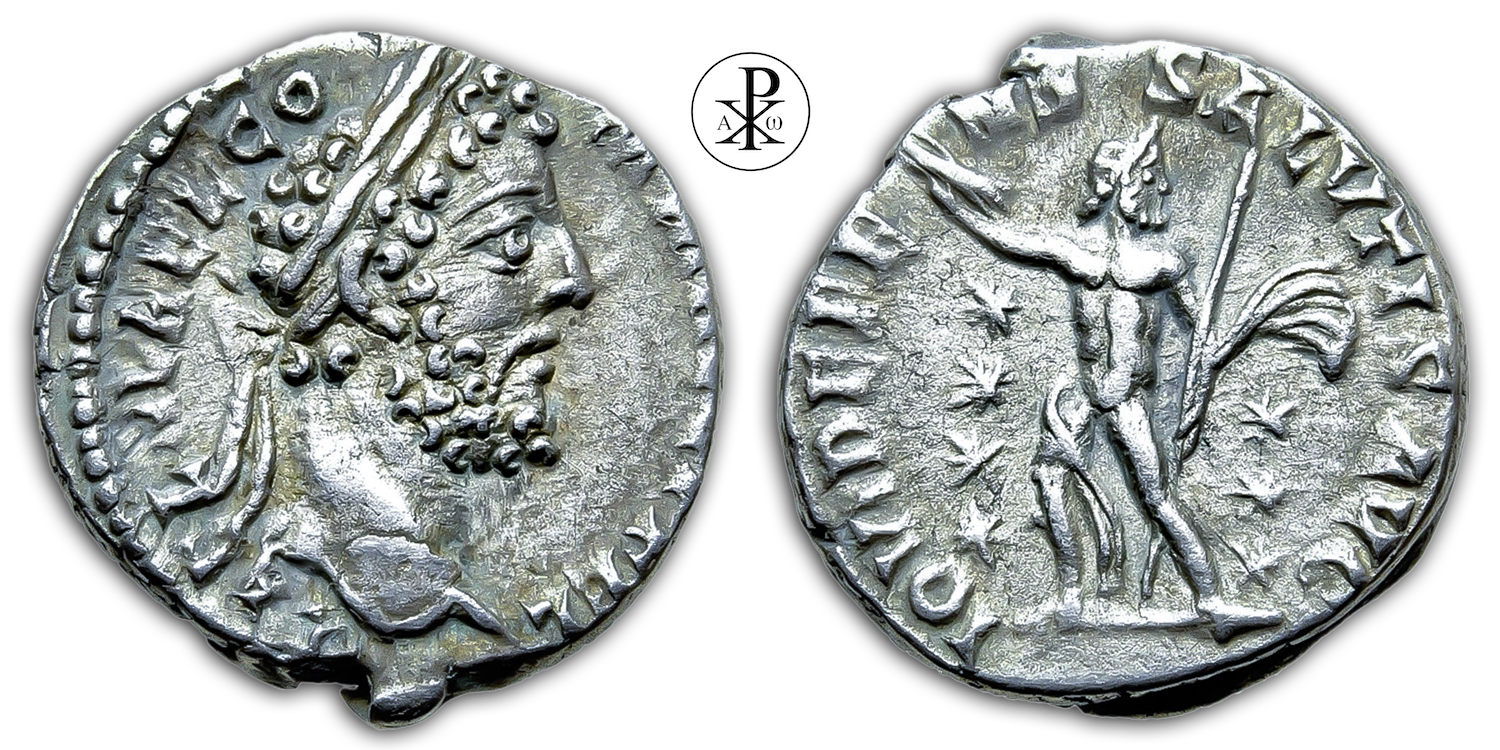Imperator Caesar Lucius Aelius Aurelius Commodus Augustus Pius Felix
Reign: Commodus
Mint: Rome
Date: 191 AD
Nominal: Denarius
Material: Silver
Diameter: 17mm
Weight: 3.33g
Reference: RIC III Commodus 256
OCRE Online: http://numismatics.org/ocre/id/ric.3.com.256
Rare: R2
Provenance: Naumann Numismatik Vienna, Austria (Auction 127, Lot 666)
Pedigree: –
Special: Commodus „Protector Series“
Obverse: Head of Commodus, laureate, right
Inscription: L AEL AVREL COMM AVG P FEL
Translation: Lucius Aelius Aurelius Commodus Augustus Pius Felix
Translation: Lucius Aelius Aurelius Commodus, the pious and fortunate Augustus
Reverse: Jupiter, nude, standing right, right foot drawn back, holding spear in left hand and hurling thunderbolt with right hand; in field, seven stars
Inscription: IOVI DEFENS SALVTIS AVG
Translation: Iovi Defensor Salutis Augusti
Translation: Jupiter, the protector of the emperor’s health
Comment: This Commodus denarius type belongs to the so-called „protector series“. The coin types of this series have the following features in common: a) all pieces lack the indication of Tribunicia Potestate, b) each specimen bears the new obverse legend with Lucius Aelius, used since 191 AD, c) the names of the addressed protector deities are without exception in the dative case and d) none of these types was ever issued under Commodus before, nor will it be issued again afterwards. The dating of the „protector series“ depends solely on the adoption of the new name. The „protector series“ includes, as an example, Jupiter Optimus Maximus sponsor securitatus Augusti (on sestertii, denarii, and silver quinarii; RIC 226, 255, 596) – standing next to the emperor Commodus (holding the globe) and laying his hand protectively on his shoulder. Jupiter defensor salutis Augusti (on sesterces and denarii; RIC 256, 597) – standing, about to hurl the bundle of lightning; in the field seven stars. Kybele as Mater deum conservatrix Augusti (on sesterces and denarii; RIC 258, 599) – depicted riding a lion. Serapis as conservator Augusti (on sesterces, dupondia, aces, aurei and denarii; RIC 261, 601, 605, 607). Mars ultor Augusti (on sesterces, dupondia and denarii; RIC 257, 598, 604). About the intention for the issue of this complete series by Commodus – there are different approaches to explain the possible background. However, none is considered as historically secured. Already Beaujeu noticed the togetherness of the whole types. Mars ultor, which now displaces the previously minted Mars pactor, in association with the other (mentioned) patron deities, would speak for the uncovering of a military plot in the last months of the year 191 AD. The Fides militum type of the following year 192 AD continues the series and is another indication of such a plot (RIC 232-234).
Chantraine interprets the protector series differently: „so much seems to me to be certain that in 191/192 AD Commodus called upon all his protecting gods, the gods who had obviously stood by him when his life and rule were threatened. What prima facie seemed to be a victorious intrusion of foreign gods in the wake of the currents of the times or possible whims of the ruler, turned out to be a personal commitment of the emperor based on concrete situations.“ He points out that according to the literary sources, two of the deities mentioned can be linked to the assassinations of Commodus: Jupiter and Magna Mater. Thus, the (alleged) conspiracy of Perennis, according to Herodian, is said to have indicated itself to the emperor on the feast of Jupiter Capitolinus. The assassination plot of Maternus, uncovered just in time, was to take place on the feast of Magna Mater. Chantraine now relates the two versions of Jupiter to the Perennis affair, the Kybele coinage to the failed assassination attempt of Maternus, and the Serapis conservator Augusti issues to the fall of Cleander. What remains is Mars ultor Augusti alone, which he assigns to the Lucilla conspiracy with a question mark.
Beaujeu’s suggestion of a military conspiracy has some merit, since the so-called „defectio of Alexander“ created another threat situation against Commodus – which even in the Historia Augusta, next to the conspiracy of Lucilla, was given greater importance. Julius Alexander (also known as Julius Alexander of Emesa) was prince from the Royal family of Emesa who lived in the 2nd century. He may have been a possible kinsman of the Roman Empress Julia Domna, which could explain him as a possible ancestor of the Roman emperor of the 3rd century Alexander Severus. In his career, Alexander became a Bestiarius also known as an animal fighter. Alexander became a prowess at Lion-hunting. He was known to have brought down a Lion with his javelin while on horseback. His prowess of his profession, provoked the jealousy of the Roman emperor Commodus. There is a possibility that Lion hunting was a royal or imperial activity that Alexander may had deliberately participated in because he may had wanted the Roman throne for himself. Commodus had sent assassins after him, whereupon Alexander tried to flee to the barbarians. However, he had all his enemies killed in his native Emesa before fleeing – which indicates that he had a certain power base. He then committed suicide while fleeing – apparently not wanting to leave his teenage male lover behind. Grosso considers that the actual „defectio“ may have taken place in Rome.
In summary, two possible logical motivations for the Protectors series can be discerned. In the last months of AD 191 and the beginning of AD 192, one or more spectacular threats to Commodus‘ government and life occurred again – the circumstances of which signified the issuance of the Protectors series. Alternatively, the series is to be understood as Commodus‘ honoratio to his protective gods, who had guided the emperor’s fortunes with divine providence over the years. Primary source: „Maria Regina Kaiser-Raiß; Die stadtrömische Münzprägung während der Alleinherrschaft des Commodus“.
